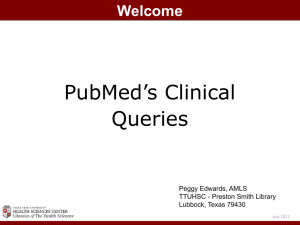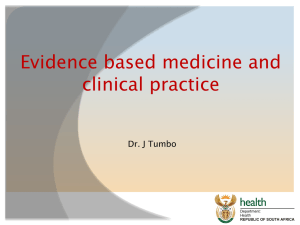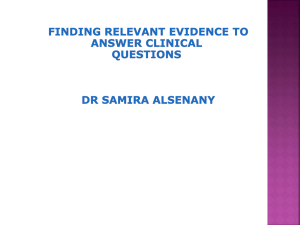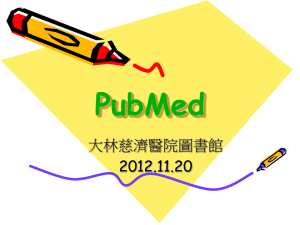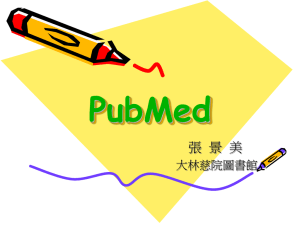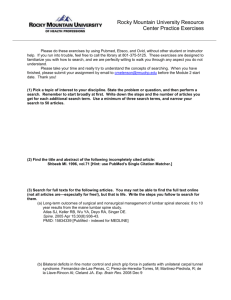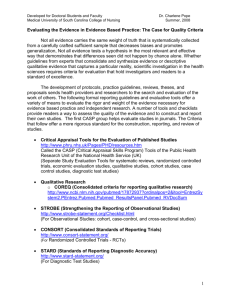Using Clinical Databases for Evidence-Based Practice
advertisement
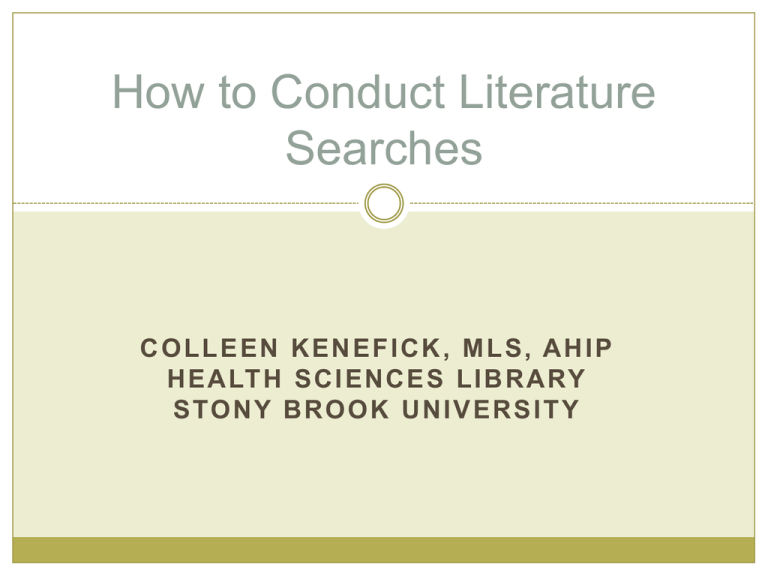
How to Conduct Literature Searches COLLEEN KENEFICK, MLS, AHIP H E A LT H S C I E N C E S L I B R A RY S TO N Y B R O O K U N I V E R S I T Y It All Starts Here Health Sciences Library Website Provides access to all electronic and print resources available from the library Medicine Subject Guide Provides electronic and print resources for all subject areas of medicine My students are dismayed when I say to them, “Half of what you are taught as medical students will in 10 years have been shown to be wrong. And the trouble is, none of your teachers knows which half.” Dr. Sydney Burwell Dean of the Harvard Medical School, 1956 Annual Addition of Articles to MEDLINE (PubMed) Types of Clinical Questions Background questions ask for general knowledge about a topic, and generally involves who, what, when, why, where, or how To answer, use electronic textbooks or other print reference sources: AccessMedicine textbooks such as Harrison’s Online First Consult MDConsult textbooks such as Rosen’s Emergency Medicine UpToDate Types of Clinical Questions Foreground questions apply to a specific patient or problem To answer, search for peer-reviewed journal articles and other EBM literature The Cochrane Library Ovid MEDLINE or PubMed TRIP Database Web of Science Four Step Program for Finding the Evidence Focus your question by using the PICO model Select appropriate information sources to answer your question Choose databases or other sources with best coverage of the topic Devise search strategy using subject terms, thesaurus, or index entries What is a Well-Built Question? A well-built question is: Directly relevant to the problem Focused and clearly formulated Sufficiently specific to ensure a clear answer Articulated to facilitate searching for an answer The PICO Model A well framed question addresses a relationship between these four components: P = the patient or problem being addressed I = the intervention or exposure under consideration C = a comparison intervention or exposure O = clinical outcome(s) of interest Four Basic Categories of Clinical Questions Therapy Diagnosis Prognosis Harm/Exposure or Prevention Therapy Cochrane Library TRIP Database PubMed Clinical Queries+ PubMed MeSH 1 2 3 4 2 1* Diagnosis Prognosis Harm/Exposure or Prevention 1** 1 2*** 1=the most high yield place to start +Use Systematic Reviews (click on Clinical Queries under PubMed Tools) to locate systematic reviews, meta-analyses, reviews of clinical trials, evidence-based medicine, consensus development conferences, and guidelines *Use diagnosis category **Use prognosis category ***Use MeSH headings and subheadings Translating a Question into a Database Search You will need to modify your answerable question (PICO) to formulate a database strategy Your PICO question may be either too specific or too broad to easily search on MEDLINE (PubMed) or one of the other available medicine databases Finding a Therapy Answer Systematic review or randomized controlled study is best feasible study design First place to look for answer: Cochrane Library TRIP Database PubMed Clinical Queries PubMed MeSH Finding a Diagnosis Answer Cross-sectional study is best feasible study design First place to look for answer: PubMed Clinical Queries (use diagnosis category and Broad Scope) TRIP Database Finding a Prognosis Answer Cohort study is best feasible study design First place to look for answer: PubMed Clinical Queries (use prognosis category and Broad Scope) These questions share three elements: a qualitative aspect, a quantitative aspect, and a temporal aspect Finding a Harm/Exposure or Prevention Answer Cohort study is best feasible study design First place to look for answer: Cochrane Database of Systematic Reviews Next best place is PubMed MeSH The Evidence Pyramid MA SR RCT Cohort Studies Case Control Studies Case Series / Case Reports Expert Opinion Animal Research / In Vitro Studies MA=Meta-Analysis, SR=Systematic Review, RCT=Randomized Controlled Trial Synonyms and Controlled Vocabulary The main point to remember is that if a database offers a controlled vocabulary, use it in addition to textwords or keywords. In PubMed (MEDLINE) the controlled vocabulary is called MeSH (Medical Subject Headings) Using PubMed Clinical Queries Use the built-in filters for: etiology diagnosis therapy prognosis clinical prediction guides You must indicate your preference for either: narrow, specific search – will miss a few relevant articles broad, sensitive search – will include irrelevant articles PubMed Clinical Queries The Top Seven Databases Cochrane Library Faculty of 1000 Health & Psychosocial Instruments (HaPI) Journal Citation Reports (JCR) PubMed TRIP Database Web of Science Five Steps to Conducting a Systematic Review Step 1. Frame the questions for your research project Should be in the form of clear, unambiguous and structured questions before starting Modify your question only if alternative ways of defining the populations, interventions, outcomes or study designs become apparent Journal of the Royal Society of Medicine 2003 Mar;96(3):118-21. Five steps to conducting a systematic review. Khan KS, Kunz R, Kleijnen J, Antes G Five Steps to Conducting a Systematic Review Step 2. Identifying relevant work Multiple databases should be searched using study selection criteria already decided upon by the research question Reasons for inclusion or exclusion is documented Keep your search strategy (in addition to citations) from each database Journal of the Royal Society of Medicine 2003 Mar;96(3):118-21. Five steps to conducting a systematic review. Khan KS, Kunz R, Kleijnen J, Antes G Five Steps to Conducting a Systematic Review Step 3. Assessing the quality of studies Quality is relevant to each step Use general critical appraisal guides or design-based quality checklists These will make it easier to decide what to include or exclude Journal of the Royal Society of Medicine 2003 Mar;96(3):118-21. Five steps to conducting a systematic review. Khan KS, Kunz R, Kleijnen J, Antes G Five Steps to Conducting a Systematic Review Step 4. Summarizing the evidence Tabulate study characteristics If you are not doing a meta-analysis, then analyze the sub-groups separately Journal of the Royal Society of Medicine 2003 Mar;96(3):118-21. Five steps to conducting a systematic review. Khan KS, Kunz R, Kleijnen J, Antes G Five Steps to Conducting a Systematic Review Step 5. Interpreting the findings Publication or other bias is explored Can the overall summary be trusted? Any recommendations should be graded by strengths and weaknesses of the evidence Journal of the Royal Society of Medicine 2003 Mar;96(3):118-21. Five steps to conducting a systematic review. Khan KS, Kunz R, Kleijnen J, Antes G Save Citations in Electronic Form In almost every database, there are four options for saving references once you have found relevant material. Print Email Save to file Export to bibliographic management software such as EndNote or Zotero (http://www.zotero.org) Click Here for My NCBI Sign In Using EndNote X5 Download EndNote Software Here Any Questions?


